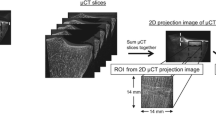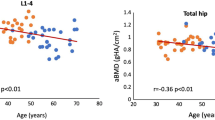Abstract
The contribution of trabecular bone structure to bone strength is of considerable interest in the study of osteoporosis and other disorders characterized by changes in the skeletal system. Magnetic resonance (MR) imaging of trabecular bone has emerged as a promising technique for assessing trabecular bone structure. In this in vitro study we compare the measures of trabecular structure obtained using MR imaging and higher-resolution X-ray tomographic microscopy (XTM) imaging of cubes from human distal radii. The XTM image resolution is similar to that obtained from histomorphometric sections (18 µm isotropic), while the MR images are obtained at a resolution comparable to that achievable in vivo (156×156×300 µm). Standard histomorphometric measures, such as trabecular bone area fraction (synonymous with BV/TV), trabecular width, trabecular spacing and trabecular number, texture-related measures and three-dimensional connectivity (first Betti number/volume) of the trabecular network have been derived from these images. The variation in these parameters as a function of resolution, and the relationship between the structural parameters, bone mineral density and the elastic modulus are also examined. In MR images, because the resolution is comparable to the trabecular dimensions, partial volume effects occur, which complicate the segmentation of the image into bone and marrow phases. Using a standardized thresholding criterion for all images we find that there is an overestimation of trabecular bone area fraction (∼3 times), trabecular width (∼3 times), fractal dimension (∼1.4 times) and first Betti number/ volume (∼10 times), and an underestimation of trabecular spacing (∼1.6 times) in the MR images compared with the 18-µm XTM images. However, even for a factor of 9 difference in spatial resolution, the differences in the morphological trabecular structure measures ranged from a factor of 1.4 to 3.0. We have found that trabecular width, area fraction, number, fractal dimension and Betti number/volume measured from the XTM and MR images increases, while trabecular spacing decreases, as the bone mineral density and elastic modulus increase. A preliminary bivariate analysis showed that in addition to bone mineral density alone, the Betti number, trabecular number and spacing contributed to the prediction of the elastic modulus. This preliminary study indicates that measures of trabecular bone structure using MR imaging may play a role in the study of osteoporosis.
Similar content being viewed by others
References
Feldkamp LA, Goldstein SA, Parfitt AM, Jesion G, Kleerekoper M. The direct examination of Sthree-dimensional bone architecture in vitro by computed tomography. J Bone Miner Res 1989;4:3.
Muller R, Hahn M, Vogel M, Delling G, Ruegsegger P. Morphometric analysis of non-invasively assessed bone biopsies: comparison of high resolution computed tomography and histologic sections. Bone 1996;8:215.
Muller R, Hildebrand T, Ruegsegger P. Non-invasive bone biopsy: a new method to analyze and display three dimensional structure of trabecular bone. Phys Med Biol 1994;39:145.
Bonse U, Busch F, Gunnewig O, et al. 3D computed x-ray tomography of human cancellous bone at 8 µm spatial resolution and 10−4 energy resolution. Bone Miner 1994;25:25.
Kinney JH, Lane NE, Haupt DL. In vivo, three dimensional microscopy of trabecular bone. J Bone Miner Res 1995;10:264.
Majumdar S, Newitt D, Jergas M, Gies A, Chiu E, Osman D, et al. Evaluation of technical factors affecting the quntitation of trabecular bone structure using magnetic resonance imaging. Bone 1995;17:417.
Chung HW, Wehrli FW, Williams JL, Kugelmass SD, Wehrli S. Quantitative analysis of trabecular microstructure by 400 MHz nuclear magnetic resonance imaging. J Bone Miner Res 1995;10:803.
Hipp JA, Jansujwicz A, Simmons CA, Snyder B. Trabecular bone morphology using micro-magnetic resonance imaging. J Bone Miner Res 1996;11:286.
Majumdar S, Genant HK, Grampp S, Jergas MD, Newitt DC, Gies AA. Analysis of trabecular bone structure in the distal radius using high resolution MRI. Eur Radiol 1994;4:517.
Hagiwara S, Lane N, Engelke K, Sebastian A, Kimmell DB, Genant HK. Prescision and accuracy for rat whole body and femur bone mineral determination with dual X-ray absorptio-metry. Bone Miner 1993;22:57.
Kinney JH, Nichols MC. Xray tomographic microscopy (XTM) using synchrotron radiation. Annu Rev Mater Sci 1992;22:121.
Foo TK, Shellock FG, Hayes CE, Schenck JF, Slayman BE. High-resolution MR imaging of the wrist and eye with short TR, short TE, and partial-echo acquisition. Radiology 1992;183:277.
Schlenker RA, Von Seggen WW. The distribution of cortical and trabecular bone mass along the lengths of the radius and ulna and the implications for in vivo bone mass measurements. Calcif Tissue Res 1976;20:41.
Linde F, Gothgen CB, Hvid I, Pongsoipetch B, Bentzen S. Mechanical properties of bone by a non-destructive compression testing approach. Eng Med 1988;17:23.
Newitt DC, Majumdar S, Jergas M, Keaveny T, Genant HK. Relaxation and high resolution MRI of vertebral body specimens: T2′, structural and strength correlations. Eleventh International Bone Densitometry Workshop, 1995:61.
Bhagwandien R, Moerland MA, Bakker CJ, Beersma R, Lagen-dijk JJ. Numerical analysis of the magnetic field for arbitary magnetic susceptibility distributions in 3D. Magn Reson Imaging 1994;12:101.
Jara H, Wehrli FW, Chung H, Ford JC. High-resolution variable flip angle 3D MR imaging of trabecular microstructure in vivo. Magn Reson Med 1993;29:528.
Muller R, Roller B, Hildebrand T, Ruegsegger P. Three dimensional microtomography of trabecular bone: micro-structural properties and resolution dependence. Eleventh International Bone Densitometry Workshop, 1995:73.
Muller R, Ruegsegger P. In vivo assessment of three dimensional structural properties of cancellous bone: a reproducibility study. Eleventh International Bone Densitometry Workshop, 1995:73.
Author information
Authors and Affiliations
Corresponding author
Rights and permissions
About this article
Cite this article
Majumdar, S., Newitt, D., Mathur, A. et al. Magnetic resonance imaging of trabecular bone structure in the distal radius: Relationship with X-ray tomographic microscopy and biomechanics. Osteoporosis Int 6, 376–385 (1996). https://doi.org/10.1007/BF01623011
Received:
Accepted:
Issue Date:
DOI: https://doi.org/10.1007/BF01623011




